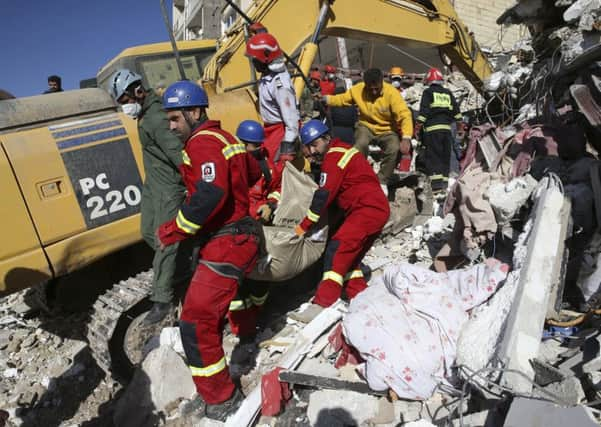Women call out for God as dead pulled from earthquake rubble


Rescuers have used backhoes and heavy equipment to dig through the debris of buildings toppled by a powerful earthquake on the border between Iran and Iraq that killed more than 530 people, with weeping women crying out to God as aid workers found new bodies.
The grim work started in earnest yesterday at dawn in the Kurdish town of Sarpol-e-Zahab in the western Iranian province of Kermanshah, which appears to be the hardest hit by the magnitude 7.3 earthquake.
Advertisement
Hide AdAdvertisement
Hide AdKermanshah, an almost entirely Kurdish province nestled in the Zagros Mountains running along the border with Iraq, suffered all of Iran’s fatalities from the disaster Sunday night that shook 14 of the country’s 31 provinces. Both rescuers and residents alike stood atop the remains of apartment complexes looking through the rubble. They used heavy blankets to carry away corpses.
The hospital in Sarpol-e-Zahab was heavily damaged. The army set up field hospitals, although many of the injured were moved to other cities, including Tehran.
The quake also damaged an army garrison and buildings in the border city and killed an unspecified number of soldiers.
There were fears more dead could be found in the rubble in Sarpol-e-Zahab and other rural villages of Kermanshah province.
Mohammad Ali Monshizadeh, a spokesman for the provincial forensic department, said as many as 150 people had been buried by family members after the earthquake in remote villages who had not been counted in the official death toll.
President Hassan Rouhani arrived in Kermanshah province yesterday to see the damage for himself.
“This was a pain for all Iranians,” Mr Rouhani said. “Representing the nation of Iran, I offer my condolences to the people of Kermanshah and tell them that all of us are behind Kermanshah.”
Iran’s Foreign Minister Mohammad Javad Zarif offered his thanks to foreign countries offering to help, but wrote on Twitter: “For now, we are able to manage with our own resources.”
Advertisement
Hide AdAdvertisement
Hide AdCleric Abdolhossein Moezi said there was a need for more relief material and “security.” That sentiment was echoed by Nazar Barani, the mayor of the town of Ezgeleh. He told state TV his constituency still had a “deep need” for food, medicine and tents. Mr Barani said 80 per cent of the buildings in the town had been damaged by the quake.
Many of the heavily damaged complexes in Sarpol-e-Zahab were part of construction projects under former hard-line president Mahmoud Ahmadinejad. The newly homeless slept outside in the cold, huddled around makeshift fires for warmth. An estimated 7,460 people were also injured in Iran.
Most of the injuries were minor with fewer than 1,000 still hospitalised.
The quake was centred about 19 miles outside the eastern Iraqi city of Halabja and struck 14 miles below the surface, a somewhat shallow depth that can cause broader damage. The quake caused Dubai’s skyscrapers to sway and could be felt 660 miles away on the Mediterranean coast.
Seven deaths occurred in Iraq and 535 people were injured, all in the country’s northern Kurdish region. The disparity in casualty tolls immediately drew questions from Iranians, especially because so much of the town was new.
Sarpol-e-Zahab fell to the troops of Iraqi dictator Saddam Hussein during his 1980 invasion of Iran, which sparked the eight-year war between the two countries that killed one million people. The area was clawed back by Iran, but remained a war zone that suffered through Saddam’s missile attacks.